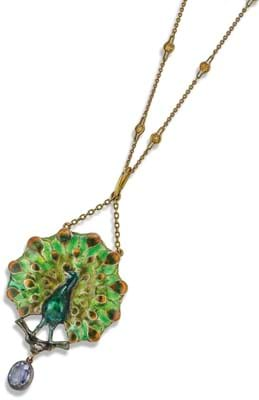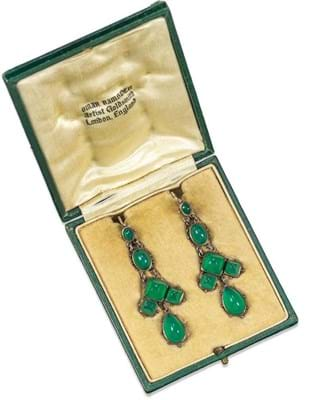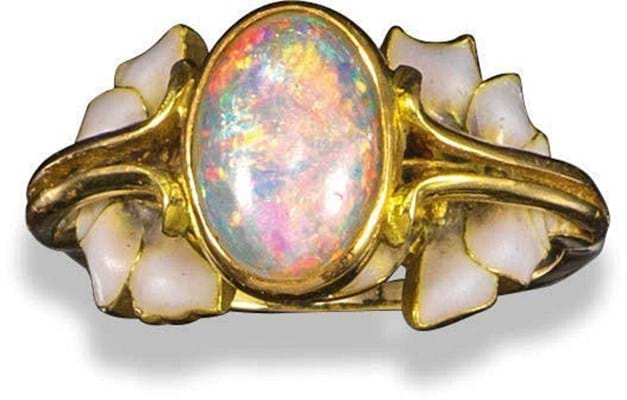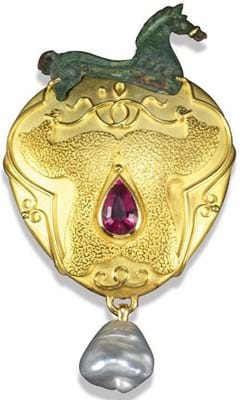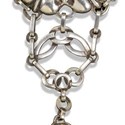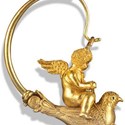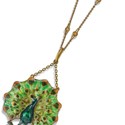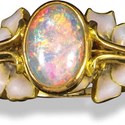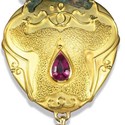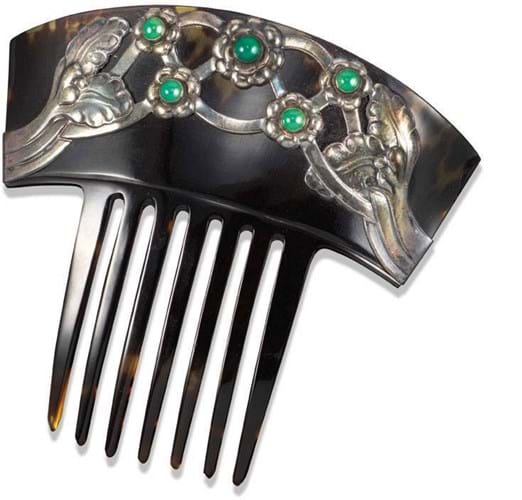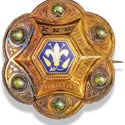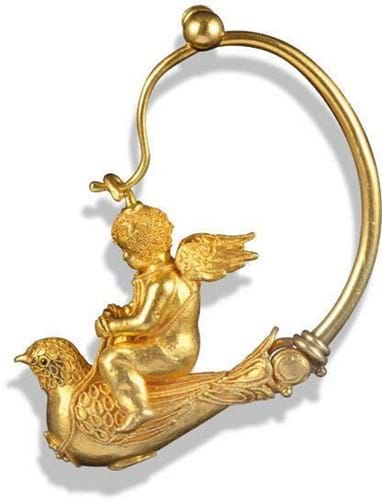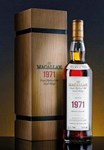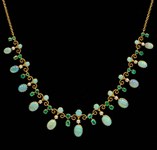“Anne’s ethos was to prize creativity and workmanship over intrinsic value. There were no big diamonds, Kashmir sapphires or Burmese rubies. She did not chase the rising markets. Instead she admired creators.”
In the wake of a £590,000, white-glove sale at Woolley & Wallis on October 31, head of the jewellery department Marielle Whiting succinctly summed up the acquisitive spirit of Buckinghamshire collector Anne Shannon.
The retired doctor, a member of the Society of Jewellery Historians, began her interest in ‘signed and designed’ jewellery while a GP in London in the Swinging Sixties. It was a time when many now familiar ‘greats’ from the corpus of 19th and 20th century makers were enjoying a first return to fashion and were accessible both in terms of price and availability. She continued to buy until the early years of the 21st century.
Whiting had first seen the collection on a winter’s day earlier this year. “Overwhelming doesn’t quite cover the feeling of entering a dining room to over 400 jewellery boxes laid out on every available surface. I remember thinking, we should never have stopped for coffee en route.”
She was asked to present the collection – that for some years had languished in a bank vault – for sale in a way that would provide a lasting showcase of a lifetime’s work. The Halloween day sale was titled Jewellery by Design: The Collection of Dr Anne Shannon, An Academic Eye. The vendor and family members were seated at the front of a packed room alongside jewellery historian John Benjamin to watch it unfold.
Plenty of treats. Perhaps the only trick was the estimates. Importantly, given the volume of material, most of the 297 lots were offered with estimates that the market found deeply attractive.
As evidenced by the survival of so many original purchase receipts, most were way below the retail prices Shannon had paid.
The tried and tested policy worked its usual magic and commission bids – plus a record number of registered online bidders and a bank of 20 phones – covered almost every lot before the auction began. Ultimately, most things made their price and more.
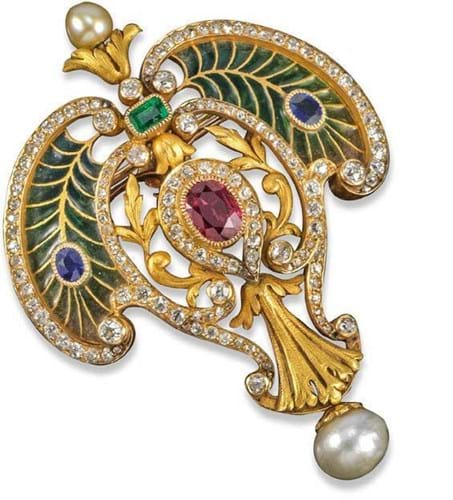
An Art Nouveau ruby, diamond, natural pearl and plique-a-jour enamel brooch pendant by Falize c.1895, £17,500.
By way of just two examples, an Art Nouveau gold, opal and enamel ring by René Lalique, accompanied by 2003 receipt from Epoque Fine Jewels, Belgium, for the equivalent of around £7000, was estimated at £1500-2000. A Falize ruby, diamond, natural pearl and plique-à-jour enamel brooch pendant bought from John Joseph in 2001 for £12,500 was pitched at £2000-3000. They found buyers at £18,000 and £17,500 respectively.
Georg Jensen
Georg Jensen silver and gemstone jewels were Shannon’s first collecting passion. She bought first on her own taste and was later guided in her quarry by Michael von Essen, the long-time head of Jensen’s antiques department and museum in Copenhagen.
In short, this was a quite different offering to the typical Jensen sale: 86 lots heavily weighted towards designs from the first quarter of the 20th century rather than post-war Modernism.
Together they attracted a very specific audience: buyers from the English-speaking countries and Scandinavia plus the Far Eastern nations such as China, Japan and Taiwan where the Jensen brand resonates today. Many pieces were sold online at prices way above the modest guides.
In keeping with a sale that promised something for the entry-level buyer, prices started at £190 for a 2½in (6cm) dove brooch made (post 1930) to a Deco design by Christian Mohl-Hansen. However, many more pieces were priced at £500-1500.
The strongest bids were reserved for ‘mark and period’ pieces from the early 20th century. Sold at £1800 was a silver and cabochon garnet foliate brooch design no 42, c.1904-08 while £2600 was bid for a bracelet of the same period with openwork foliate links set with green agate cabochons.
Leading this section at £5200 was a pendant set with amber cabochons within a silver casework frame. Numbered design no 46 and dated to the final years before the First World War, it was one of several pieces in the sale that had featured in Janet Druker’s book Georg Jensen: A Tradition of Splendid Silver. Estimated at £600-800, it took £5200.
Child & Child
Walter Child (1840-1930) and Harold Child (1848-1915), the sons of an East End pawnbroker who left a fortune of £30,000, opened as art jewellers in 1880 at 1 Seville Street, Belgravia.
Shannon’s enthusiasm for the firm’s distinctive stock of enamelled and gem-set jewellery put her in good company: in its pomp C&C attracted the patronage of Queen Victoria, Edward VII and the Tsarina of Russia and a number of artists.
Sir Edward Burne-Jones is thought to have designed a number of pieces: a simple pair of gold and green-stained ivory heart-shaped cufflinks c.1880 were among his designs issued commercially in the 1880s. They sold at £3400.
A total of 26 pieces made this the biggest offering in memory. Most dated from the period between 1891-1916, when Child & Child was located at 35 Alfred Place (now Thurloe Street) close to South Kensington tube station. The firm’s trade mark (C&C with a sunflower between) can still be seen moulded in plaster above a first-floor window.
A gold and enamel peacock pendant c.1905, in a fitted case with this address was one of several pieces purchased in the 1990s from Didier Antiques, London. Sold at retail in October 1996 for £1750, it took £4700.
However, the biggest battle of the day in Salisbury was reserved for a suite of five silver and enamel butterfly brooches that were chosen as the catalogue illustration. The largest of the group, at 2½in (6cm) across with a garnet thorax, had been bought from the Tadema Gallery in 1997 for £1800; the four others bought together from Sarah Groombridge, London, in 1999 for £1450. A determined private phone buyer secured them all with four bids totalling £16,800.
“The butterflies jumped out at me immediately” said Whiting. “I knew they would be the perfect front cover and provide the theme of regeneration: as one person says goodbye to a collection so many of these pieces will be welcomed into another.”
Omar Ramsden
While volunteering a day a week at Goldsmiths Hall to help in the archiving of Omar Ramsden design drawings, Shannon began to collect Ramsden and Ramsden & Carr jewellery. She ultimately owned 35 hallmarked or attributed pieces – surely the largest single group of jewels by a firm much better known for silversmithing.
There was not a huge amount to go on in terms of auction precedent but this section provided a sale-topping gold bracelet selling at £22,000.
Composed of four uniform square plaques, each set with four conical chrysoprase cabochons, a Gothic script letter spells out the name Anne – a clue to its creation for Ramsden’s wife, Anne (nee Downs Butcher). It has hallmarked for 1931 and is typically engraved Omar Ramsden Me Fecit MCMXXXI. It comfortably exceeded pre-sale expectations of £2000-3000 before selling to a private UK buyer – also called Anne.
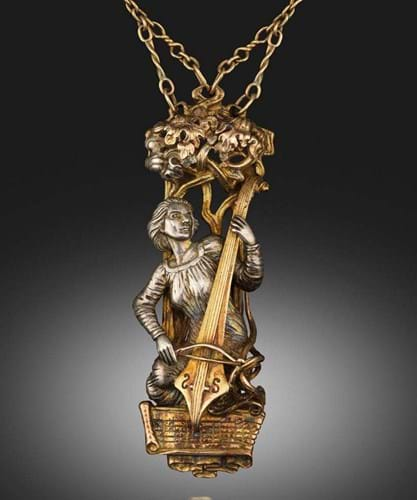
A silver gilt medieval revival pendant by Omar Ramsden engraved with the inscription I was wrought by command of John de Seyfried for Alma his wife MCMXXVIII (1928), sold for £6100.
Other highpoints in the Ramsden section included a pair of earrings, each with six graduated cabochons in silver beaded mounts c.1925 sold at £5000 and a ‘medieval’ silver-gilt pendant necklace modelled as a kneeling maiden playing a stringed instrument engraved with an inscription for 1928 sold at £6100.
In crude investment terms they presented contrasting fortunes. Both were sold with original purchase receipts from 1997: the earrings bought from John Jesse for £1500, the pendant from Wartski at £9500.
Other Arts & Crafts
In her long collecting journey, Shannon came to embrace a range of designers and makers from the period whose work formed sub-sections within an increasingly important collection.
Frequent visits to London antique jewellery dealers and auctions widened her subject knowledge and sphere of interest to include a range of British jewellers working in the Arts & Crafts or Art Nouveau idiom. She was buying heavily in the late 1990s.
Alongside Ramsden, a roster of names from Murrle Bennett and the Gaskins to Dorrie Nosier were represented. Highlights included a gold, pearl, emerald and garnet pendant by The Artificer’s Guild, c.1905 (bought for £3300 at Tadema in 1997 and sold here at £3600); a silver and enamel necklace and pendant set with emerald and ruby cabochons attributed to Henry Wilson, c.1900 (bought for £2500 at John Jesse and sold at £3500) and a silver, enamel, seed pearl and moonstone pendant by George Hunt, c.1933, decorated as a pannier of flowers (bought for £4300 at Tadema and sold for £3200).
Revivalism
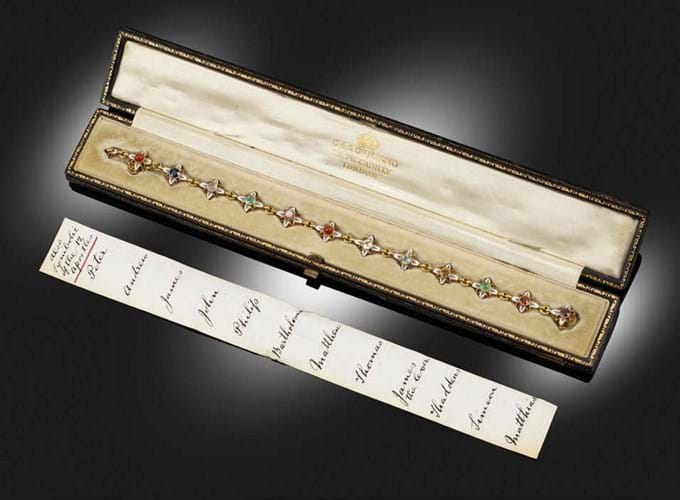
Bringing the five hours of selling to a financial crescendo was a series of what John Benjamin had dubbed “totemic pieces” by celebrated 19th century revivalist goldsmiths.
There were, in particular, two spectacular gem-set pearl, gold and enamel pendant necklaces by Carlo Giuliano, one with a necklace comprising six rows of pearls in the Indian taste, the other decorated with typical white and black enamel links separated with a seed pearl. Both took £17,000 each.
Among the most storied pieces on offer – and the most eagerly contested – was a coloured stone and enamel gold bracelet by Giuliano made c.1896 using the gemstones of the Apostles.
In the building of Paradise in the Book of Revelations, 12 stones are awarded a virtue: jasper (constancy); sapphire (beautiful thoughts); chalcedony (zeal); emerald (suavity of manner); sardonyx (teaching); sard (readiness for martyrdom); chrysolite (restrained by no obstacles); topaz (uprightness); chrysophase (sight), beryl (goodness of mind); jacinth (calmness) and amethyst (sobriety).
This bracelet, accompanied by a handwritten ‘key’ and a 1994 purchase receipt from SJ Phillips for £9000, sold via thesaleroom.com for £16,000 (estimate £2000-3000).





